"Pin" Culture in the Coffee Museum many museums in Vienna

The picture shows Meyer introducing the coffee machine made in Austria in the 1930s.
Of the many museums in Vienna, the Coffee Museum, which opened only in 2003, is perhaps the youngest. Walking into this museum, there is a very strong Viennese coffee culture. The director of the museum, Mr. Ednunde Meyer, warmly welcomed us into a "coffee world" that is both familiar and unfamiliar.
Coffee is the "first drink" of mankind. Meyer said that the current global coffee production of about 150 million bags (60 kg each), consumption of more than 130 million bags, taking into account reserves and other factors, basically in a state of balance between supply and demand. Finland consumes 12 kilograms of coffee per person per year, and the average person drinks 4.6 cups per day, which is the "world champion". Austria consumes 6.1 kg of coffee per capita per year, ranking 16th in the world. Although coffee is not produced in Europe, 13 of the 20 countries with the highest per capita consumption are European countries.
There are different opinions about the origin of coffee, and some legends are covered with mystery. There are more than 16000 books about coffee in the world, but there are only 2000 books about potatoes and only 10, 000 books about wine. It can be seen that people have a special preference for coffee. It is generally believed in academic circles that coffee originated in Ethiopia, where there are many wild "berry" trees, where nomads went there in the 9th century or earlier to buy "berries" to make soup. Avicenna, a famous Persian doctor, recognized the excitatory effect of coffee in 1015 and put it into medicine. In the 11th century, Arabs began to grow coffee on the slopes along the Red Sea, and Yemenis began to roast their harvested coffee beans on stone slices.
At present, there are two main types of coffee beans, one is called Arabica, which was found in Ethiopia in 1542, and the other is called Robusta, which was found in Uganda in 1860. The biggest difference between the two types of coffee is the taste, the former is characterized by soft fragrance, the latter is characterized by strong, the latter has twice as much caffeine as the former.
Meyer said that about 3000 exhibits on display at the Coffee Museum cover all aspects of Vienna's coffee culture and are the result of his efforts to collect them for half a century. In addition to coffee beans, coffee machines, coffee utensils and coffee shop equipment, he also collected many posters and books about coffee. He grew up in his parents' coffee shop. In 1950, his father bought a high-pressure steam coffee machine, which made him very excited. He was much more interested in the coffee machine than in running the coffee shop. In 1960 he began to sell all kinds of coffee machines. From then on, he began to collect everything about coffee. Although he has retired for five years, he still runs classes, gives lectures, introduces coffee culture and how to make coffee. He said he trained baristas at McDonald's fast food restaurants in Austria. Perhaps in order for us to taste his craftsmanship, he walked up to a coffee machine with the sign "do not touch the exhibits" and turned on the power supply. Soon the fragrant coffee came out, and then he foamed the milk in the metal milk cup with high-pressure steam, and only saw his hand shake a few times, and the white foam appeared as a "Christmas tree" on the brown coffee. And all this, only in a few seconds. 'it takes 7 grams of coffee powder to make a cup of coffee,'he said. 'more will be bitter, less will be light. Of course, water quality is very important, and the hardness of water quality is 7. If the water is too hard, it will taste bitter; if the water is too soft, it will taste sour. In addition, caffeine dissolves easily in water and not easily in milk.
Coffee first appeared in Vienna in 1665, brought by two Armenian spice merchants, later than both the Netherlands and Italy. Meyer said that some people were willing to postpone the coffee history in Vienna until 1683, when Vienna defeated the siege of 200000 Turkish troops, leaving nearly 500 bags of coffee beans when the Turkish army fled, which became an important material basis for Vienna to make coffee history.
Viennese do not drink coffee the most, but they have formed a unique coffee culture, whose main features are: first, there must be dance music. A large number of dance music created by many music masters, such as Strauss and his son, are played in cafes. Second, they must be able to play cards and chess. At present, there are still cafes in Vienna for guests to play chess and cards; third, there must be newspapers. The cafe with the most subscriptions offers 230 newspapers and periodicals, while the few offer more than 20. The "newspaper reading folder" that people now use was invented by the owner of a cafe in Vienna. The "newspaper folder" not only prevents "shoplifting" from taking away the newspaper, but also facilitates reading. Fourth, the diversity of coffee. There are hundreds of varieties of Viennese coffee, and dozens of varieties of coffee are provided by ordinary cafes.
In addition, the established cafes in Vienna have specific consumer groups. For example, the main customers of the Central Cafe are writers, while the Speer Cafe is a gathering place for painters and artists. There is also a silent language in the cafe, such as putting a cup of water in front of you and holding the newspaper straight in your hand, indicating that you do not want to be disturbed; for example, putting 2 cups of water and holding the newspaper obliquely, indicating that you can ask if you can share the table with him; if there are three cups of water, the newspaper is flat, indicating that others are welcome to chat. Viennese coffee culture has also spawned related industries. Meyer took out a chair with a round back and said that it is a classic coffee chair made by an Austrian company and has sold 50 million worldwide since it was introduced in 1880.
Viennese coffee has long been a cultural business card of Austria. About 90% of the more than 10 million visitors to Vienna every year experience its coffee culture. Source: Guangming Daily
Important Notice :
前街咖啡 FrontStreet Coffee has moved to new addredd:
FrontStreet Coffee Address: 315,Donghua East Road,GuangZhou
Tel:020 38364473
- Prev

Paris Metro and Cafe Culture, France
The subway culture in Paris is the place where the urban middle class is most concentrated, especially during the rush hour. Through the subway, which reflects the culture of the city, we can learn a lot about the city and culture. While working in Paris, I have to change lines three times a day to get to and from work, and take the subway back and forth for three hours, so I am impressed by the Paris subway.
- Next

Moderate and rational Central and Northern European Coffee Culture is rational and mild
Unlike the Italians as enthusiastic, nor as romantic as the French, people in central and northern Europe drink coffee rationally and gently, just like their organized nationality. European life and coffee have become almost inextricably linked, except for the unusual way of drinking coffee in Italy and France, from Austria, Switzerland, Germany to the north.
Related
- How did the Salvadoran coffee industry develop in Central America?
- What exactly does the golden cup extraction of coffee mean?
- The Origin of Coffee flower
- [2023 Starbucks World Earth Day] there are more meaningful things besides free Starbucks coffee!
- What kind of coffee is there in Spain? 9 Flavors of Spanish Coffee
- Aromatic African coffee| Kenya's coffee culture and historical production area
- Liberica Coffee Bean knowledge: the characteristics of Liberian Coffee beans of the three original species of Coffee beans
- The origin and formula of Spanish latte introduces the taste characteristics of Bombon coffee in Valencia, Spain.
- How to adjust the solution of over-extracted coffee
- What is the tasting period of coffee beans? What is the period of coffee and beans? How should coffee wake up and raise beans?

